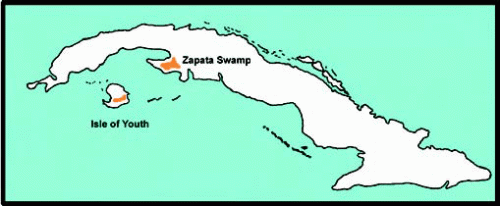The Crocodiles of Cuba
March 1, 2012 by dykerr
Cuba is proud of its natural resources. Beyond the fertility of the Cuban campo and the famous beauty of its playas, the island boasts one of the most diverse, unique, and protected natural environments of the Caribbean. Cuba’s large swaths of forest and wetlands are home to many species of flora and fauna found nowhere else on earth. Of all these rare endemic species, perhaps none is as visible, or as threatened, as the Cuban crocodile, Crocodylus rhombifer. Found in just two Cuban swamps and likely numbering only 4000 individuals in the wild, the Cuban croc is one of the rarest crocodilians on earth. While efforts are being made to protect the species from extinction, the future of the Cuban crocodile remains uncertain in the face of increasing development on the island and rapidly changing environmental conditions in these fragile ecosystems.
While the Cuban crocodile originally ranged throughout Cuba and sometimes even to neighboring islands, today the population is confined to Zapata Swamp on the southwestern coast of Cuba and in Lanier Swamp on the Isle of Youth. In these natural locales, the crocodiles live as they always have, lurking in freshwater swamps and flooded fields as they hunt for turtles, fish, and small mammals. These crocodiles are particularly well adapted to capturing their prey; they have long legs and are comfortable walking and even running out of the water. They can also leap several feet straight into the air to grab animals out of tree branches. Cuban crocs are widely regarded as the most pugnacious of the New World crocodilians, although they have been reported to be among the most intelligent as well, able to respond to names and simple commands.
Several factors contribute to the decline of the Cuban crocodile in the wild. As with many species the world over, Cuban crocs are threatened with habitat destruction as more and more ecosystems are destroyed to make room for human habitation and use. The risk for island species is especially high because land in these areas is both highly limited and highly desirable. That being said, the Cuban government has made several attempts to preserve their natural environments, including creating the Zapata Biosphere Reserve, the largest protected area in the entire Caribbean at 1.5 million acres. Island endemics are also at risk due to their naturally small numbers and often-precarious environs; disasters such as hurricanes often wreak destruction on these fragile ecosystems. Additionally, Cuban crocodiles are known to interbreed with their cousin, the American crocodile. The resultant hybrids pollute the gene pool and threaten the purity of the species.
By far the biggest strain on the Cuban crocodile population is hunting by locals, which has increased since the 1990s in response to food shortages on the island. The tail meat of these reptiles is regarded as both delicious and a natural aphrodisiac. Additionally, many crocodiles are killed in the wild to be sold in the tourist industry, as meat for restaurants, skin for belts and handbags, or curios for travelers. These activities continue despite the protected status of most of the crocodiles’ territory.
To combat these threats, the Cuban government has implemented several plans of actions. The first and perhaps most important is the previously mentioned creation of protected areas on the island, including the Zapata Biosphere Reserve. The reserve is one of Cuba’s several national parks, and has been deemed a Wetland of International Importance by the IUCN. The area is set aside for the islands species, and access to visitors is limited. There are also several government-authorized crocodile farms on the island, which breed the animals for both human consumption and reintroduction into the wild. The crocodile population on the Isle of Youth is a direct result of these efforts. There has also been some success in breeding the crocodiles at other crocodile farms around the world.
Cuba is a one-of-a-kind place on many levels, not the least of which is its biodiversity. The Cuban crocodile is just one example of an endemic species that faces extinction if steps are not taken to ensure its survival. While the Cuban government has taken some steps in this direction, the crocodiles’ future remains uncertain. Only time will tell if these aggressive, ancient reptiles will continue to stalk the swamps of Cuba.
Sources:
http://www.iucnredlist.org/apps/redlist/details/5670/0
http://www.iucncsg.org/ph1/modules/Publications/ActionPlan3/ap2010_19.html
http://crocodilian.com/cnhc/csp_crho.htm
http://ngm.nationalgeographic.com/ngm/0311/feature4/index.html?fs=www7.nationalgeographic.com
Leave a Reply
You must be logged in to post a comment.


